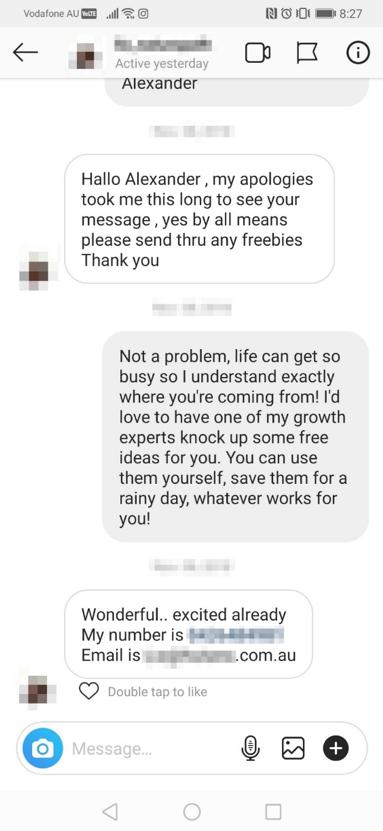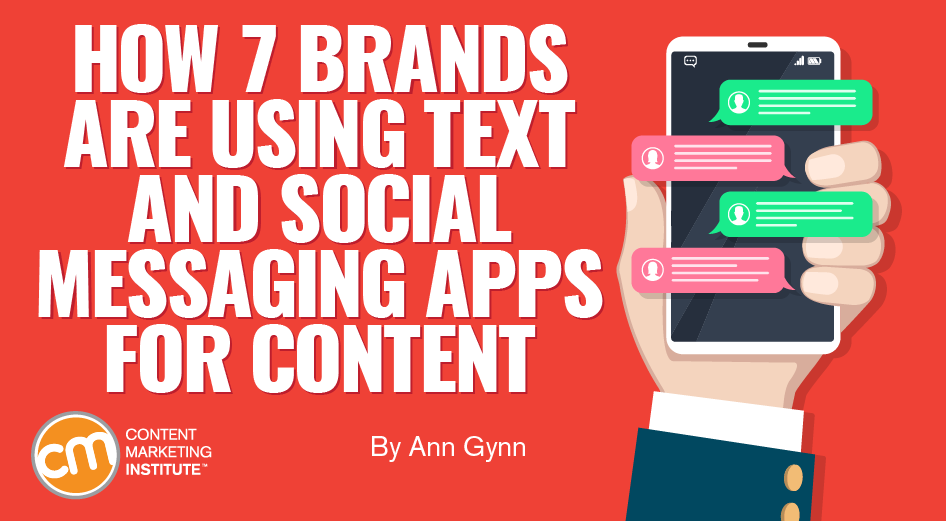 Smart content marketers meet the audience where it is.
Smart content marketers meet the audience where it is.
People are on their mobile phones (3.5 billion in 2020) and on social media messaging platforms (e.g., Facebook has 1.3 million active monthly users).
Smart marketers also know that one-to-one marketing elicits a better response than one-to-many.
Direct messaging via text and social media seems like a good fit based on both these realities. Research backs up the promise: Over 90% of users who opted to receive texts from a brand see those messages as “somewhat” or “very useful,” according to Salesforce’s Mobile Behavior Report. (Of those who didn’t opt in to a brand’s text messaging, 52% said it was because they found it disruptive.)
90%+ of users who opt in to receive texts from brands say it’s somewhat or very useful. @Salesforce via @cmicontent Click To TweetIn a Facebook survey, almost 70% of consumers said they feel more confident about brands they can message (and they exchange about 10 billion messages with brands each month on Facebook). Of course, that also means over 30% don’t like it or don’t care about messaging brands.
That’s why discerning marketers are exploring the opportunities to distribute content through these channels, figuring out whether their audience wants content that way and what content to provide.
Learn from the experiences of seven brands that have used or are using texts and messaging to distribute their content and connect with their audiences.
1. Get CTR results three times better than email
When people download the app from Chanty, an AI-powered team chat, they can opt to receive messages from the company’s Facebook Messenger bot.
“When we have an exciting piece of content or announcement, we send direct messages through this bot,” says Olga Mykhoparkina, chief marketing officer. The Chanty customer support team replies directly to each message received from the audience.
The results have been phenomenal. “It’s blown email out of the water in terms of open and click-through rates,” Olga says. One Facebook Messenger campaign saw a 30% click-through rate compared to less than 10% for an email campaign.
Chanty’s #Facebook Messenger campaign saw a 30% CTR compared to less than 10% for an #email campaign, says @olmykh via @AnnGynn. Click To Tweet2. Give the non-promotional touch
David Stroh, a marketing consultant and real estate agent at Re/Max Plus in Frederick, Maryland, says his industry is moving heavily toward text messaging because it’s an easy, “soft touch” form of marketing.
In his own business, David successfully uses text messages to reconnect with clients and potential clients. The texts may be information specific to the client or broader messages that would benefit multiple clients.
“Even texts with links to websites have good conversion success,” David says. “They aren’t being perceived as too pushy or intrusive by most clients.”
I use texts with links to websites to reconnect with clients and potential clients. They have good conversion success, says @DavidStrohRE via @AnnGynn. Click To TweetThe key is to send your audience something helpful or valuable. “Let them know about an event they may be interested in, share a tip or trick that is industry specific, or remind them of what your company/you do that is different and beneficial to their situation,” David explains.
For example, David strategically texts his first-time homebuyers to help them become better educated about real estate. “I use text marketing to invite them to events where they can learn about the process. I share info and tips about programs they could benefit from, or I update them on others like them that have realized the benefits of home ownership,” he says.
What content he sends also depends on the relationship. For prospects with whom David has spoken once (and hasn’t heard back), he’ll use the CRM to send a group or mass text to maximize his content’s reach. The closer the relationship is, the more likely he is to type the text with more personalized information to drive the conversation.
HANDPICKED RELATED CONTENT:
3. Educate, engage, and sell
Moriarty’s Gem Art, a family-owned jewelry business, uses text marketing for promotions and content distribution.
“We do a lot of educational videos, and normally have a blog along with them,” explains Jeff Moriarty, marketing manager. “For our content-based text campaigns, we normally include a description of the content and a screenshot of the video itself.”
Jeff says that while they don’t see many sales from the content as compared to their promotional texts, the text campaigns create interaction and engagement with their subscriber list in a way they couldn’t do anywhere else.
TIP: Collect mobile numbers in the checkout process, like Moriarty’s Gem Art does. Then you can use those opt-in customers to grow the post-sale relationship by text.
4. Grow from 5 to 1,000 subscribers in 3 months with respectful 2-way communication
Lindsey Eryn is the founder of Third Story Apartment design studio. She focuses strictly on non-promotional (i.e., special offer) texts.
She is a client of SimpleTexting.net. Its marketing manager, Alfredo Salkeld, shared Lindsey’s story. Lindsey offers a daily inspirational text or “pep talk” to entrepreneurs, business owners, and young professionals. Recipients sometimes reply and Lindsey responds to each message individually.
“This allows her to get to know members of her audience on a deeper level than she would in the comments section of a Facebook post, for example. She can build authentic, one-on-one relationships,” Alfredo says.
Within three months of starting the program, she went from five subscribers to over 1,000 subscribers who volunteered their mobile numbers. “Texts have helped her strengthen her brand, build her network, and acquire leads for her business,” Alfredo says.
Lindsey, like other successful marketers, recognizes the honor of accessing someone’s text message inbox, which normally is reserved for family and friends. As Alfredo explains, “That’s a big deal. It means they really want to hear from you. This, plus the fact that texting is a two-way channel, makes it perfect for content marketing.”
5. Know when to stop
English Blinds experimented with but quickly discarded a text-based marketing program. “Many of our customers – even those who had proactively opted in to receive marketing communications – viewed such an approach very negatively,” says Polly Kay, senior marketing manager.
Many @EnglishBlinds’ customers viewed their text marketing very negatively, says Polly Kay via @AnnGynn. Click To TweetShe thinks text messaging marketing is less widely used today than five years ago because of the growth of alternative messaging services like Facebook Messenger and WhatsApp. “We found (our texts) were at best being viewed as spam, and being ignored, or at worst, generating an actively hostile response in our prospects,” Polly says.
English Blinds also heard from a customer who explains she uses texting to stay in contact with older relatives who might need help. When she hears a text notification, she is relieved but frustrated when she opens it to find it’s a marketing message.
The company has never pursued direct messaging via social channels because of the feedback from the in-house marketing team, customers, and a random sampling of non-marketing staff. All indicated social messaging would be seen as intrusive and hamper the brand’s reputation.
“In-stream Messenger ads, on the other hand, offer a softer sell approach for better middle ground for us, and this is something we’re currently integrating into Facebook campaigns,” Polly says.
6. Respect your audience’s trust
Though Search It Local has found success and positive feedback using text messaging to send sales and marketing tips to its subscribers, it’s not for every company, says Alexander Porter, marketing team leader, Search It Local, a digital marketing agency.
Brands and marketers always should exercise caution with this strategy. “An SMS opt-in signals great trust. It takes very little time to break this trust, and a very long time to build it back up,” he says.
Brands and marketers always should exercise caution with a text messaging strategy. It takes very little time to break trust, says @SearchItSocial via @AnnGynn. Click To TweetThat’s why Search It Local pulls its texting audience from its customer database. “With the trust required to successfully implement SMS marketing, we feel providing current clients with resources can help guide them to upsell and cross-sell opportunities with more success than messaging cold contacts gathered through a lead form,” Alexander says.

Search It Local also has experimented with direct messaging on Instagram. Unlike texting where it connects with customers, it targets prospects who fit its client personas on Instagram. And the results reflect that broader approach with lower open and click-through rates compared to SMS marketing.
But direct texting and Instagram messaging have something in common. Audiences on both platforms prefer video content (though Search It Local’s messaging differs on each channel).
“This video content is designed to be educational and informative with little to no conversion opportunities,” Alexander says. “Again, these channels represent trust, and self-promoting in an overt way can destroy your connection with prospects.”
7. Build a knowledge-source reputation
In a niche industry, finding and connecting with your prospective clients can be a challenge.
A cloud-based compliance service that helps government construction contractors comply with certified payroll laws, eBacon turned to one-to-one marketing to find its narrow niche. It uses LinkedIn’s InMail.
“We operate in a very niche B2B market segment. We primarily target finance/payroll people or owners in the construction industry. These professionals can be best connected with through LinkedIn from previous sales experience,” says Abel Hegyes, eBacon’s marketing specialist.
They like the more “intimate” yet professional setting, Abel says, noting they have received a few requests for more information but haven’t seen much success from this approach.
“Our main goal is to establish brand recognition and tangentially gain leads. We have been looking to build our brand and establish it as a knowledge source for government construction contractors … We wanted to keep our potential prospects educated on the latest law changes and compliance requirements. This helps to establish trust and brand recognition,” Abel explains.
Let your fingers do the marketing
If direct messaging via text and social media hasn’t hit your company’s radar yet, think about implementing a pilot program in 2020. To make it manageable, don’t create new content. Think about what content you already are creating, then figure out how to package it for distribution and/or promotion through text-based or social media messaging.
Already using text-based or social media messaging for your content marketing? Add your tips, successes, lessons learned, etc., in the comments.
Want to learn more lessons in content marketing? Enroll before Dec. 15 in Content Marketing University for the winter semester.
Cover image by Joseph Kalinowski/Content Marketing Institute

